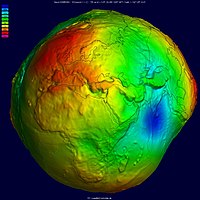
Photo from wikipedia
Airborne gravity gradiometry is an effective tool for its high efficiency and sensitivity to the interesting buried targets, which has been increasingly introduced in mineral and petroleum exploration. When compared… Click to show full abstract
Airborne gravity gradiometry is an effective tool for its high efficiency and sensitivity to the interesting buried targets, which has been increasingly introduced in mineral and petroleum exploration. When compared to gravimetry, full tensor gradient (FTG) measurements provide higher resolution and signal-to-noise ratio. In this article, we build and test models with different sampling intervals and compare the performances of individual components or their combinations in minimum structure inversion to evaluate the benefits of FTG combinations. As part of a theoretical study, the singular value spectrum (SVS) and depth-resolution plot (DRP) are examined to determine how much information and resolution different datasets provide in the underdetermined inverse problem. The synthetic examples show that integrating more components in inversion improves the resolution of the recovered model, and the inversion result of gravity or individual component cannot accurately restore the distribution of anomalous bodies. With the increasing sampling interval, joint inversion of FTG data still provides enough information corresponding to the source density distribution, and the limit survey interval is tested through models. In addition, we use a real survey over the Vinton dome as a case study and discover that $V_{\mathrm {zz}}$ component fails to reconstruct the caprock model at coarse line spacing, whereas FTG combinations recover the acceptable geometry flawlessly. It also reflects the benefit of FTG combinations for inversion processing, which reduces the interference of measured noise on inversion results and allows for longer sampling intervals during the survey, effectively lowering the cost of an airborne survey and improving exploration efficiency
Journal Title: IEEE Transactions on Geoscience and Remote Sensing
Year Published: 2022
Link to full text (if available)
Share on Social Media: Sign Up to like & get
recommendations!